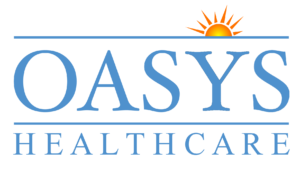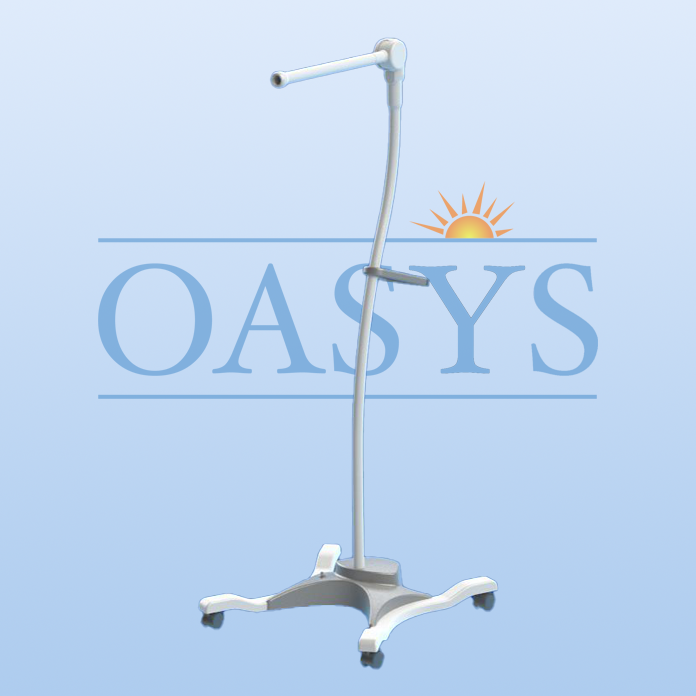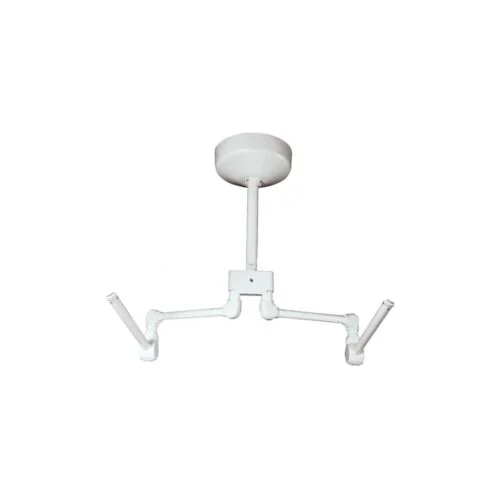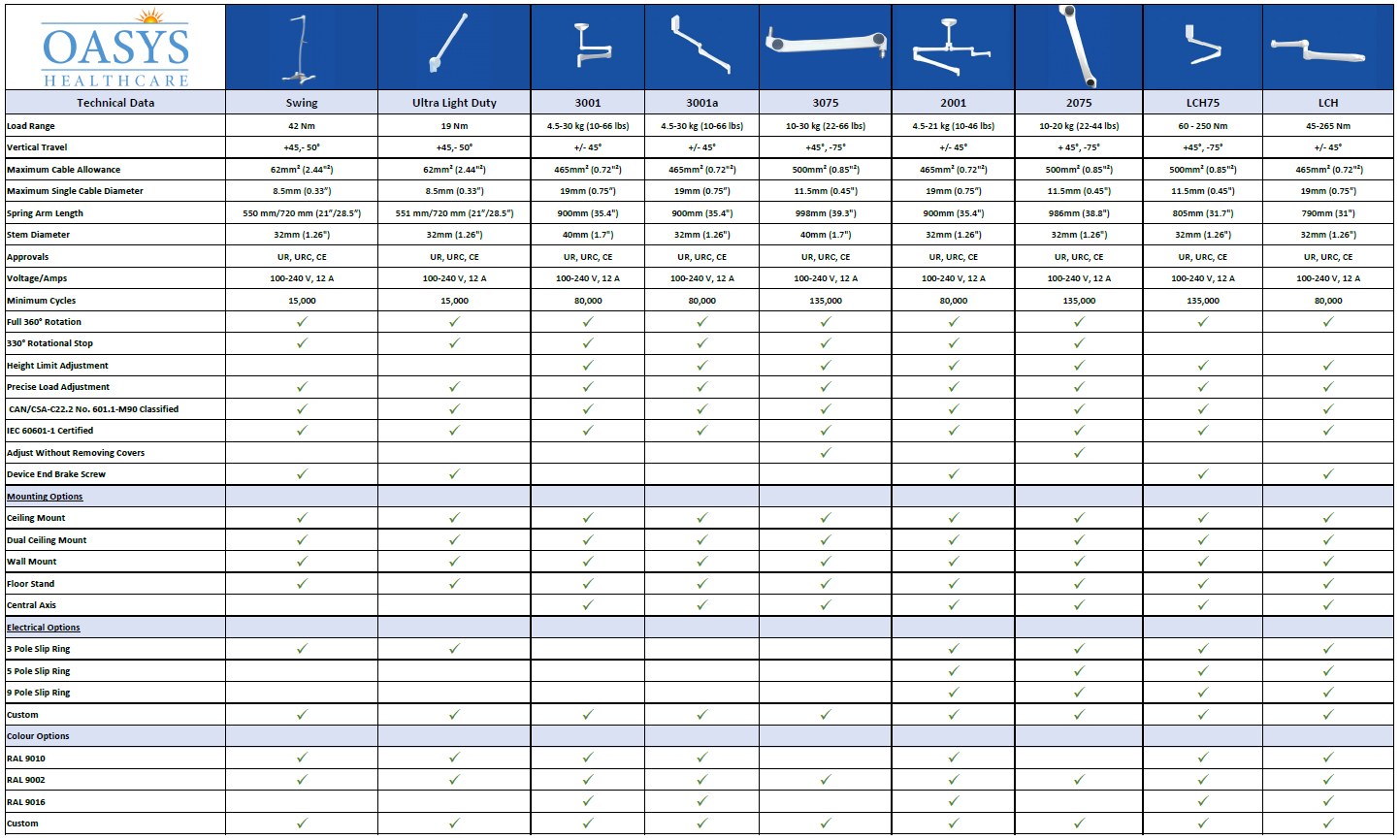OASYS Swing Spring Arms
In the realm of medical and industrial equipment management, the efficiency and reliability of equipment suspension systems are paramount. The OASYS Swing Spring arms stand out as a versatile and highly customizable solution for handling various equipment loads. Whether it’s cameras, examination lights, or other critical medical devices, OASYS Swing arms are engineered to meet specific requirements with superior functionality and precision.
Overview of OASYS Swing Spring Arms
The OASYS Swing Spring arms are designed to accommodate a diverse range of equipment weighing up to 7 kg (15 lbs). This innovative suspension system facilitates the seamless mobility and effortless positioning of adapted equipment across ceiling, wall, or floor stand models. OASYS’s commitment to providing high-quality, customized solutions ensures that each unit is tailored to meet the unique needs of its users, enhancing both usability and operational efficiency.
Versatile Load Handling
One of the standout features of the OASYS Swing Spring arms is their capability to handle a wide range of loads. With a maximum load capacity of 42 Nm, the system can manage varying equipment weights effectively, making it suitable for applications requiring different lighting or device configurations. This flexibility is critical in environments where equipment demands can fluctuate, such as in operating rooms or industrial workspaces.
Customization Options
OASYS understands that no two applications are identical. Therefore, Swing arms offer extensive customization options in terms of length, load, and color. The spring arm lengths are available in 550 mm and 720 mm (21″ and 28.5″) for straight arms and 720 mm (28.5″) for bent arms. Additionally, extension arms are offered in lengths of 800 mm and 1270 mm (31.5″ and 50″) for wall or ceiling mounts, ensuring that the suspension system can be tailored to specific spatial and functional requirements.
OASYS Swing spring arms come in standard RAL 9010 (pure white), or can be customized with any color, allowing for aesthetic integration with existing equipment or room decor. This level of customization ensures that the OASYS Swing arms not only meet functional needs but also blend seamlessly into their environment.
Ease of Mobility and Positioning
Designed for effortless mobility, the OASYS Swing arms facilitate smooth travel of attached equipment. The suspension system supports easy maneuverability, allowing users to position cameras, lights, or other devices precisely where they are needed with minimal effort. This ease of positioning is essential in medical settings where quick and accurate adjustments can significantly impact patient care and procedure efficiency.
Robust Design and Safety
The OASYS Swing Spring arms are engineered with a focus on durability and safety. Each arm is built to support four times the payload towards yield strength according to IEC 60601 standards. This ensures that the system can withstand the rigors of daily use while maintaining reliable performance. Additionally, the arms are approved by UR, URC, and CE, and comply with IEC 60601-1, UL 60601-1, and CAN/CSA-C22.2 No. 601.1-M90 classifications, providing users with confidence in their safety and compliance with international standards.
Technical Specifications
- Spring Arm Length: 550 mm and 720 mm (21″ and 28.5″) for straight arms; 720 mm (28.5″) for bent arms.
- Extension Arm Length: 800 mm and 1270 mm (31.5″ and 50″) for wall/ceiling mount only.
- Maximum Load: 42 Nm for both straight and bent arms.
- Load Ranges: 3-15 Nm and 14-42 Nm for both straight and bent arms.
- Drop Tube Length, Ceiling: 150-800 mm (6″-31.5″) for both straight and bent arms.
- Maximum Cable Allowance: 62 mm² (2.44 in²).
- Maximum Single Cable Diameter: 8.5 mm (0.33″).
- Electrical: 100-240 V, 12 A.
- Colors: RAL 9010, Custom Colors Available.
Superior Quality and Service
At the heart of the OASYS Swing Spring arms is a commitment to superior quality and customer service. Each unit is crafted to meet stringent quality standards, ensuring reliability and longevity. OASYS prides itself on providing on-time delivery and excellent customer service, addressing any concerns or customization needs promptly and effectively. This dedication to quality and service makes OASYS a trusted partner for medical and industrial equipment management solutions.
Application Versatility
The OASYS Swing arms’ design flexibility allows them to be adapted for a wide array of applications. In medical settings, they can be used to support examination lights, medical cameras, and other diagnostic equipment, providing healthcare professionals with the tools they need for accurate and efficient patient care. In industrial environments, the arms can support cameras for inspection and monitoring, ensuring that critical processes are overseen with precision.
Optional Features
To further enhance the functionality of the OASYS Swing Spring arms, optional features such as non-stop rotation are available. This allows for continuous 360-degree movement, providing even greater flexibility in positioning and maneuverability. The system is also designed to be easily serviceable, ensuring that maintenance and adjustments can be carried out with minimal disruption to operations.
Conclusion
The OASYS Swing Spring arms represent the pinnacle of design and functionality in equipment suspension systems. With their versatile load handling, extensive customization options, and robust design, they provide an ideal solution for a wide range of medical and industrial applications. The combination of superior quality, ease of mobility, and a commitment to customer satisfaction makes OASYS Swing arms a reliable choice for those seeking efficient and adaptable equipment management solutions.
For those looking to elevate their equipment suspension systems with a product that offers both flexibility and reliability, the OASYS Swing Spring arms stand as a testament to innovative engineering and dedicated service. Whether adapting to the dynamic needs of a hospital or the rigorous demands of an industrial setting, the OASYS Swing arms deliver unmatched performance and customization to meet the unique challenges of any environment.




